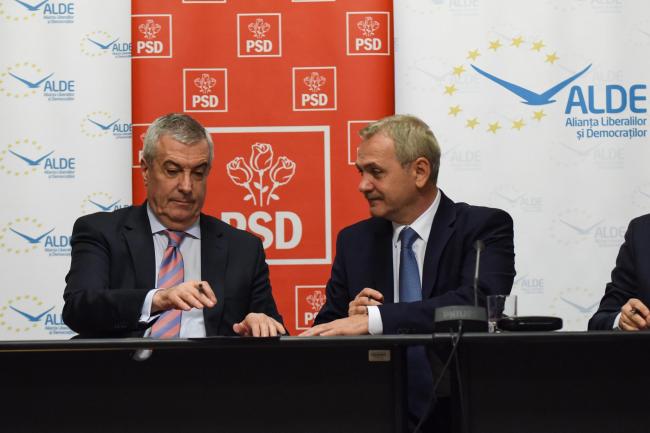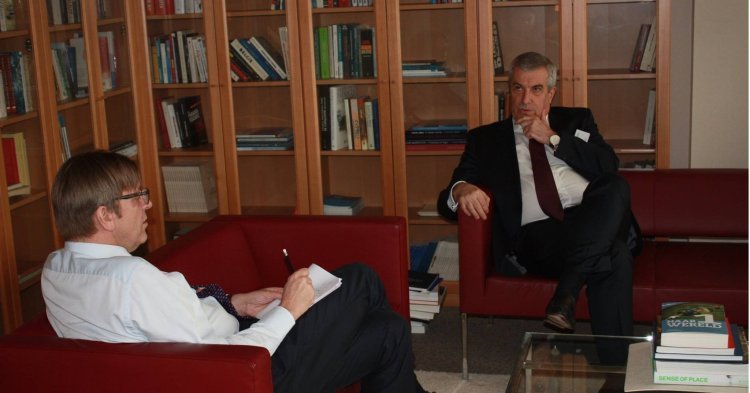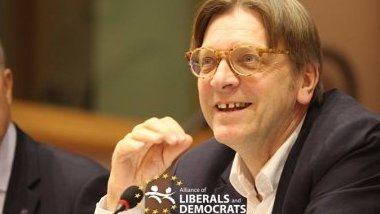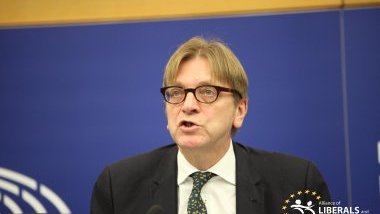A Champion of Europe
Verhofstadt has been a positive voice in Brussels and across Europe for years, receiving hate-filled titles in the Eurosceptic press, whose articles never disappoint in producing amusement – “Arch-federalist Verhofstadt calls for MORE integration as EU bloc crumbles away.” Appointed as chief negotiator of the EU for Brexit, Verhofstadt stood as a champion of the European project, all while condemning the populism and dictatorial style of government of leaders like Hungarian Prime Minister Viktor Orban.
For all these reasons, Verhofstadt is a favorite among pro-European and federalist groups. He is seen as a man who serves Europe, not just a country or a group of select states. His family of parties in the European Parliament, ALDE, heavily benefits from Verhofstadt’s light. The group consists of 60 member-parties made up of liberals, progressives and centrists that cannot integrate into the European Popular Party or the Social Democratic group, and has been using its political weight toward the safeguarding of the European project and against extremist groups.
Some of the parties that ALDE unites in the EP are Sweden’s Center Party (Centerpartiet), Spain’s Ciudadanos, UK’s Liberal Democrats, France’s Union of Democrats and Independents and many more. But it is also home to Romania’s ALDE – Alianta Liberalilor si Democratilor, the only national party in Europe which copies the ALDE initials and much of its name, but conveniently drops the “for Europe” part.
The values of Verhofstadt’s ALDE include “a more transparent, democratic and accountable Europe” which focuses on “European solutions” and promotes the principle of subsidiarity. The party also “believes in a Europe based on the fundamental Liberal principles of liberty, democracy, the rule of law, human rights, tolerance and solidarity” and strives to make a society “free from poverty, ignorance, and discrimination”, including “the right to marry for same-sex couples”.
A Corrupted Namesake
The Romanian ALDE shares the same values as its European namesake – but only in principle. In reality and in discourse, the two parties could not be ideologically further from one another, with the Romanian counterpart supporting projects like:
– the decriminalization of corruption in Romania and the politicization of the judiciary;
– the constitutional definition of the family as being made up of a woman and a man, thus crossing out sexual minorities from the protections of the law;
– the unconstitutional transformation of Romania into a de facto parliamentary democracy by way of removing the president from any meaningful role;
– backing the spend-and-borrow economic policies of its ruling coalition partners, the Social Democratic Party (PSD), that have driven Romania’s inflation up 5% in just one year;
The most obvious example of the divorce between Verhofstadt’s ALDE and its namesake in Romania bears the name of the former Romanian PM and current founder and leader of ALDE – Calin Popescu Tariceanu. ALDE Romania was entirely built around him by recruiting dissidents from the National Liberal Party (PNL), the main opposition force. Tariceanu’s discourse is a mix of closeted Euroscepticism, simplistic nationalism and the belief in the struggle against an occult “parallel state” reminiscent of the tactics of Erdogan and Orban.
A bit of history is necessary before continuing.
In 2016, Tariceanu was prosecuted for perjury and wrongdoings in the retrocession of land confiscated by the communist regime. The prosecutors worked within DNA, the National Anti-Corruption Directorate and the main watchdog of high-level corruption in the country. Ever since, Tariceanu has been trying to dismantle the institution through his position of President of the Senate. He has been doing so while in league with the tsar of the governing PSD and the President of the Chamber of Deputies, Liviu Dragnea, himselfconvicted for rigging a national referendum. The two men, both prosecuted by DNA, have been remodeling the justice system throughout the past year, an effort which culminated with their final attempt to get the chief prosecutor of DNA, Laura Codruta Kovesi, fired.
In doing so, they have redefined the form of government in Romania – a semi-presidential system – by removing the president from any position of decision-making through emergency ordinances given late at night and rulings of the subservient Constitutional Court.

Left - Calin Popescu Tariceanu, Right - Liviu Dragnea, Source: Jurnalul.ro
After inventing an enemy to win the elections, Tariceanu and Dragnea abandoned the “Soros threat” and came up with another – the “parallel state”, a shady group of intelligence officers supposedly embedded in the state apparatus and whose work represents the only barrier to Romanian prosperity. Incidentally, the stronghold of this “parallel state” is DNA and the presidency, but among their supporters Tariceanu counted the European Commission and the multinational corporations present in Romania.
However, Tariceanu’s discourse is similar to that of his socialist colleagues – appeasement and pro-Europeanism when speaking to Brussels, and occult, spy-novel scenarios involving an international cabala set to steal the riches of Romania when speaking to Romanian voters.
Romania is praised as one of the few EU countries which do not have a meaningful anti-European party. Indeed, all of the parliamentary parties of the countries declare their support for the European project and for Romania’s integration in it.
The situation looks good, on the surface. Reality is different. Pressured by charges of corruption and faced with the support given by the EU and the US to the DNA, the ruling parties often attack “the embassies” and the European Union.
In criticizing the former EU agriculture commissioner and PM Dacian Ciolos, Tariceanu argues that Romania should not be satisfied with its position “as colony in the EU” and that Ciolos would serve the “Sublime Porte” of Brussels better than his own country. The reference to the Ottoman Sublime Porte is meaningful to the Romanians, whose petty princes and rulers often had to obey and pay homage to the Ottomans.
It takes a village
Commenting the “Stop Soros” plan of Hungary, Guy Verhofstadt criticized the EPP for condoning the science-fiction scenario built by Viktor Orban around the all-powerful George Soros, an American-Hungarian financier and funder of NGOs throughout the world. As Orban’s FIDESZ party is a member of the Popular group in the European Parliament, Verhofstadt asked the populars to be held accountable.
At the same time, however, throughout the 2016 campaign, Romania’s ALDE employed the same kind of discourse, blaming George Soros and his all-power NGOs for everything that occurred within Romania, pointing to his “agents” – the opposition and critical activists.
In a post of 2015, Verhofstadt pondered on his meeting with then leader of the Liberal Reformist Party of Romania, Calin Popescu Tariceanu, saying that “we agreed that real separation of powers in Romania is key. The executive, legislative and judiciary branch have to be in balance, no one must dominate.”
Just three years later, Tariceanu is in the process of destroying rule of law in Romania and of turning the judiciary into a body that is subservient to the ruling parties, all while every law and every government act is decided at the headquarters of the parties of PSD and ALDE.
Ever since his early support for the #Rezist protests of 2017, Verhofstadt has remained silent on the topic of Romania and the misdoings of the Romanian ALDE, not to mention the openly Eurosceptic discourse of its president. While condemning Viktor Orban in Hungary, he overlooks the Orban in his party.
Why would Europe’s ALDE tolerate the Eurosceptic and paranoid Romanian ALDE within it, bearing its name – the only party that does so across Europe? As revealed by a January CURS poll in Romania, ALDE is set to rise to 9% in popularity after just making it over the 5% electoral threshold during the last elections. The party is also set to double its seats in the EP to 6. In the new European Parliament, the projected liberal centrist party of president Emmanuel Macron will represent an existential threat to ALDE, which would be left with only 57 MEPs in case of a split. Every seat counts following this scenario, and shady allies are better than no allies.
Out of the 32 seats allocated to Romania, ALDE Romania – and its independent allies – currently contributes 3 Romanian MEPs to the 60 ALDE MEPs in the European Parliament. Two of them, however, are dissidents, elected in 2014 on the lists of the National Liberal Party, a member of the EPP.
The final joke is that Renate Weber, currently an MEP of Romania’s ALDE and closely connected to Calin Popescu Tariceanu, was also Chair of the Soros Foundation in Romania between 1998 and 2007.
Who’s the “parallel state” now?




Follow the comments: |
|
